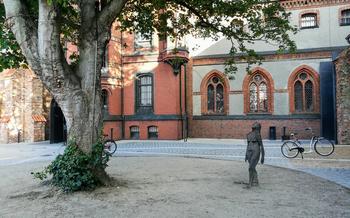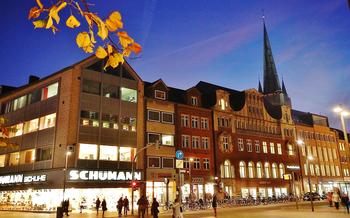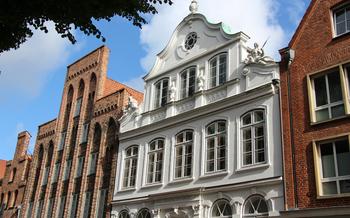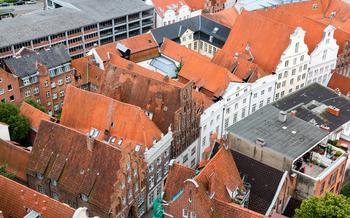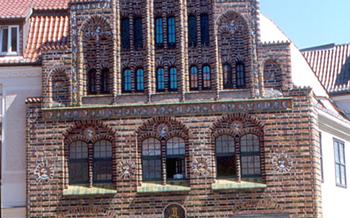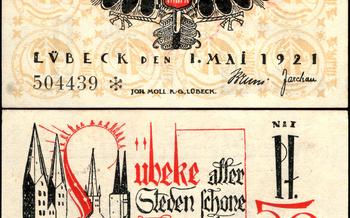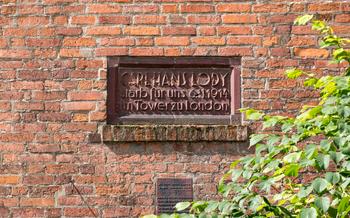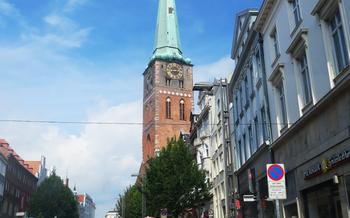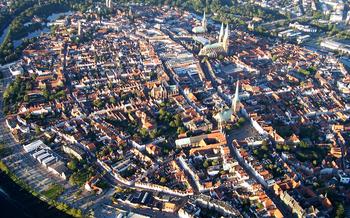
Marienkirche (St. Mary's Church)
- Lübeck's Marienkirche (St. Mary's Church): A Gothic Masterpiece
- A Journey Through Time: Exploring the Church's History
- Towering Grandeur: Ascending the Church Tower
- A Walk Through History: The Church's Neighborhood
- Unveiling the Astronomical Clock: A Mechanical Wonder
- Experience the Sounds of Music: Concerts and Events
- Discover the Crypt: Unveiling Secrets Beneath the Church
- Interactive Learning: The Church's Museum
- Guided Tours: Unveiling Hidden Stories
- Accessibility and Practical Information
- Capturing the Essence: Photography and Art
- Local Events and Traditions: A Cultural Immersion
- Exploring Beyond: Lübeck's Other Treasures
- Insider Tip: Unveiling a Hidden Gem
Lübeck's Marienkirche (St. Mary's Church): A Gothic Masterpiece
In the heart of Lübeck, the majestic Marienkirche (St. Mary's Church) stands as a testament to the city's rich history and architectural prowess. This magnificent edifice, constructed in the distinctive Brick Gothic style, is a symbol of Lübeck's prosperity and its position as a leading city in the Hanseatic League. The church's grand dimensions and intricate details reflect the city's wealth and power during the Middle Ages. As you approach this architectural wonder, its towering spires and intricate brickwork create an awe-inspiring sight, inviting you on a journey through time.
A Journey Through Time: Exploring the Church's History
The origins of Marienkirche can be traced back to the 13th century when Lübeck was a thriving city within the Hanseatic League. The construction of the church began in 1250 and spanned several decades, reflecting the city's growing wealth and prominence. During this period, Lübeck served as a major trading hub, connecting the Baltic Sea region with the rest of Europe. The church's construction symbolized the city's economic and political power, as well as its commitment to Christianity.
Over the centuries, Marienkirche witnessed significant historical events and transformations. It played a crucial role in the Reformation, becoming one of the first Lutheran churches in northern Germany. During World War II, the church suffered severe damage from Allied bombings, but its sturdy structure and intricate details were meticulously restored in the decades that followed. Today, Marienkirche stands as a testament to Lübeck's rich history, resilience, and enduring faith. Ongoing restoration efforts ensure that this architectural masterpiece continues to captivate visitors and inspire generations to come.
Towering Grandeur: Ascending the Church Tower
The Marienkirche's towering height, reaching 125 meters, beckons visitors to embark on an unforgettable journey to the heavens. The ascent to the top offers a panoramic spectacle, with breathtaking views of Lübeck's red-roofed cityscape, the winding Trave River, and the distant spires of neighboring towns. Each step reveals intricate details of the tower's design, from the delicate tracery of the windows to the intricate carvings adorning the facade. This architectural masterpiece is not just a symbol of Lübeck's prosperity but also a testament to the ingenuity and craftsmanship of its builders.
As you reach the summit, the panorama unfolds before your eyes. The city's landmarks, such as the Holstentor gate and the Town Hall, take on a new perspective from this elevated vantage point. The surrounding countryside, with its patchwork of fields, forests, and shimmering lakes, stretches out in all its glory. For centuries, the tower has served as a vital landmark for sailors navigating the Baltic Sea, guiding them safely to the port of Lübeck. Its enduring significance as a beacon of hope and guidance remains etched in the hearts of locals and visitors alike.
The climb to the top requires a bit of physical effort, but the reward is well worth it. The tower is accessible via a narrow spiral staircase, which adds to the sense of adventure. However, visitors with mobility challenges may want to consider alternative ways to experience the church's grandeur. Accessibility options, such as virtual tours or guided tours with elevators, are available to ensure that everyone can appreciate the magnificence of Marienkirche.
A Walk Through History: The Church's Neighborhood
The Marienkirche stands as a majestic beacon within Lübeck's Old Town, a UNESCO World Heritage Site. This historic district invites you to embark on a journey through time, where cobblestone streets lead you past centuries-old buildings, each whispering tales of the city's rich past.
In the shadow of the Marienkirche, you'll find a treasure trove of architectural wonders. The Town Hall, with its intricate Gothic facade, stands as a testament to Lübeck's power and prosperity during the Hanseatic League era. Nearby, the Buddenbrookhaus, once home to the fictional Buddenbrook family from Thomas Mann's renowned novel, offers a glimpse into the lives of Lübeck's merchant elite.
As you wander through the Old Town, marvel at the intricate details adorning the gabled houses and the spires of the many churches that dot the skyline. Each building tells a story, each street corner reveals a hidden gem. From the medieval Holstentor gate to the Heiligen-Geist-Hospital with its Gothic architecture and museum, Lübeck's Old Town is a living testament to the city's enduring legacy.
Unveiling the Astronomical Clock: A Mechanical Wonder
Concealed within the Marienkirche's grand interior lies a remarkable treasure—the astronomical clock. This intricate masterpiece of engineering and craftsmanship stands as a testament to the ingenuity and precision of medieval artisans. Built in the 15th century, the clock features a complex system of gears, dials, and moving parts that tell not only the time but also display the positions of the sun, moon, and stars.
As the clock strikes the hour, a procession of figures emerges from its depths, representing the various stages of life and symbolizing the passage of time. Intricately carved and painted, these figurines bring the clock to life, adding a touch of whimsy and enchantment to this mechanical marvel.
Beyond its aesthetic appeal, the astronomical clock holds historical significance as a valuable tool for navigation and timekeeping in the days before modern technology. Its intricate workings continue to fascinate visitors, offering a glimpse into the scientific advancements of the medieval era.
For those seeking a truly immersive experience, guided tours of the clock are available, providing insights into its history, symbolism, and astronomical significance. These tours offer a unique opportunity to unravel the mysteries of this remarkable creation and gain a deeper appreciation for its enduring legacy.
Practical Information for Viewing the Clock
- The astronomical clock is located on the south wall of the Marienkirche's nave.
- Guided tours of the clock are available at specific times throughout the day. Check the church's website or inquire at the information desk for details.
- The clock strikes the hour with its procession of figures, so plan your visit accordingly to witness this spectacle.
- Photography is permitted, but using a flash is not allowed to prevent damage to the delicate mechanisms.
Experience the Sounds of Music: Concerts and Events
Lübeck's Marienkirche is not only a masterpiece of architecture but also a renowned venue for music. Its exceptional acoustics and musical heritage make it a popular destination for concerts, organ recitals, and special events. The church's grand interior provides an awe-inspiring setting for musical performances, creating an unforgettable experience for attendees.
Regular concerts featuring talented musicians and renowned choirs take place throughout the year, showcasing a diverse range of genres from classical to contemporary. The church's magnificent organ, with its intricate carvings and powerful sound, is a highlight of many concerts, filling the vast space with its rich tones.
In addition to regular concerts, Marienkirche also hosts special events and festivals, such as the Lübecker Musiktage, an annual music festival featuring performances by internationally acclaimed artists. During these events, the church transforms into a vibrant hub of musical activity, attracting music lovers from across the region.
Whether you're a classical music enthusiast or simply seeking a unique and immersive cultural experience, attending a concert or event at Marienkirche is highly recommended. Check the church's website or local event listings for upcoming concerts and events, and immerse yourself in the enchanting sounds of music within this historic masterpiece.
Discover the Crypt: Unveiling Secrets Beneath the Church
Beneath the grandeur of Marienkirche lies a hidden world—the crypt. Step down into this atmospheric space, and you'll be transported back in time. The crypt served as a burial ground for prominent figures associated with the church and the city of Lübeck. Intriguing epitaphs and elaborate tombstones adorn the walls, telling tales of their lives and legacies.
One notable figure resting here is Heinrich von Ghetelen, a wealthy merchant and benefactor of Marienkirche. His impressive tombstone, featuring a life-size effigy, pays tribute to his generosity and influence. Another prominent figure is Johannes Bugenhagen, a reformer who played a crucial role in shaping Lübeck's religious landscape. His tomb, adorned with intricate carvings, reflects his significant contributions to the city's history.
Apart from these notable figures, the crypt also holds the remains of ordinary citizens who contributed to Lübeck's prosperity. Their stories, though less known, are equally poignant, offering a glimpse into the lives of those who shaped the city's past.
Visiting the crypt is an opportunity to uncover the hidden stories of Marienkirche and the people who have left their mark on Lübeck. As you wander through this solemn space, you'll gain a deeper appreciation for the church's history and the lives that have intersected within its walls.
Interactive Learning: The Church's Museum
Enhance your visit to Lübeck's Marienkirche by exploring its captivating museum, a treasure trove of knowledge and interactive exhibits. Immerse yourself in the rich history and significance of the church through engaging displays, educational materials, and hands-on experiences.
Uncover the secrets of Marienkirche's construction, restoration, and preservation efforts. Learn about the symbolism and stories behind the church's stunning artwork, including the intricate stained glass windows, exquisite altarpieces, and awe-inspiring ceiling frescoes.
Delve into the lives of notable figures associated with the church, including influential bishops, merchants, and artisans who contributed to its legacy. Discover their contributions to Lübeck's prosperity and the Hanseatic League.
The museum provides a comprehensive overview of Marienkirche's role in the city's development, from its humble beginnings to its status as a symbol of Lübeck's wealth and power. Interactive displays bring the church's history to life, making it an ideal destination for visitors of all ages.
Practical Information:
- Opening Hours: The museum shares the same opening hours as the church.
- Admission Fees: A small fee is required for entry, with discounts for students and seniors.
- Guided Tours: Guided tours of the museum are available upon request and provide an in-depth exploration of the exhibits.
- Accessibility: The museum is fully accessible for visitors with disabilities, with ramps, elevators, and accessible restrooms.
Guided Tours: Unveiling Hidden Stories
Enhance your visit to Lübeck's Marienkirche by embarking on a guided tour, led by knowledgeable and passionate experts. These tours offer an immersive experience, delving into the rich history, architecture, and significance of the church.
Professional guides will captivate you with tales of the church's construction, its role in the Hanseatic League, and its survival through the Reformation and World War II. They will point out hidden details, such as intricate carvings and symbolic motifs, that you might otherwise miss.
Thematic tours are available, catering to specific interests. For art enthusiasts, there are tours that focus on the church's stunning stained glass windows, altarpieces, and ceiling frescoes. History buffs can delve into the church's role in Lübeck's development and its connection to the Hanseatic League.
Guided tours are an excellent way to gain a deeper understanding of Marienkirche and its place in Lübeck's cultural and historical landscape. They are available in various languages and can be booked in advance or on-site.
Accessibility and Practical Information
Opening Hours and Admission Fees
The Marienkirche is open to visitors from Tuesday to Sunday, with varying hours depending on the season. Admission to the church is free, while there is a modest fee for climbing the tower and visiting the crypt. Guided tours are also available for a fee, providing in-depth insights into the church's history and significance.
Accessibility Features
The Marienkirche is committed to ensuring accessibility for all visitors. The church features wheelchair ramps and elevators, making it easy for those with limited mobility to explore the main floor and the tower. Audio guides and Braille signage are also available for visually impaired visitors.
Dress Code and Etiquette Guidelines
While there is no strict dress code for visiting the Marienkirche, it is advisable to dress respectfully, as the church is a sacred space. Visitors are asked to be mindful of noise levels and to refrain from talking or taking photographs during services.
Tips for Planning Your Visit
To make the most of your visit to the Marienkirche, plan your trip during the off-season to avoid crowds. Guided tours are highly recommended for a comprehensive understanding of the church's history and significance. Remember to check the church's website for any special events or concerts that may be taking place during your visit.
Capturing the Essence: Photography and Art
The Marienkirche's grandeur and intricate details make it a popular subject for photography enthusiasts. The play of light through the stained glass windows, the imposing tower reaching towards the sky, and the intricate carvings adorning the exterior provide endless opportunities for capturing stunning images. Join local photography tours or workshops to learn the art of photographing historical architecture and capture your own unique perspective of this iconic landmark.
Marienkirche has also inspired numerous artistic representations throughout history. Paintings, drawings, and engravings depicting the church can be found in museums and galleries across Lübeck. Take some time to explore local art galleries and exhibitions to discover how artists have interpreted and immortalized the beauty of this architectural masterpiece.
Local Events and Traditions: A Cultural Immersion
Marienkirche is not just a historical landmark but also a vibrant center for cultural events and traditions. Throughout the year, the church hosts a variety of festivals and events that celebrate its rich heritage and significance.
Join the locals in their annual celebrations, such as the "Marienfest," a traditional festival held in honor of the Virgin Mary, or the "Lübecker Weihnachtmarkt," a charming Christmas market that fills the Old Town with festive cheer. These events offer a unique opportunity to immerse yourself in Lübeck's vibrant culture and traditions.
After exploring Marienkirche, don't miss the chance to sample the local cuisine. Lübeck is renowned for its culinary delights, including the famous "Lübecker Marzipan," a sweet treat made from almonds and sugar. Indulge in this local specialty and discover the city's rich gastronomic heritage.
Exploring Beyond: Lübeck's Other Treasures
While Marienkirche stands as a beacon of Lübeck's rich history, the city offers a treasure trove of additional landmarks and attractions. Explore the majestic Lübeck Cathedral, a stunning example of Romanesque architecture. Delve into the captivating history of the city at the Museum of Lübeck, showcasing artifacts and exhibits that bring the past to life. Admire the impressive collection of medieval art at the St. Annen Museum, housed in a former monastery.
For those seeking unique experiences, embark on a leisurely stroll through the picturesque streets of the Old Town, a UNESCO World Heritage Site. Discover hidden courtyards, charming cafes, and specialty shops nestled amidst centuries-old buildings. Take advantage of Lübeck's strategic location to embark on day trips to nearby destinations. Explore the enchanting Hanseatic cities of Wismar and Stralsund, or venture into the idyllic countryside of Holstein Switzerland, renowned for its rolling hills and serene lakes.
Insider Tip: Unveiling a Hidden Gem
While exploring Lübeck, don't miss the Heiligen-Geist-Hospital, a short walk from Marienkirche. This former hospital, founded in the 13th century, is a hidden gem that offers a glimpse into medieval architecture and social welfare. Admire its Gothic facade, intricate carvings, and peaceful courtyard. Inside, the museum showcases the hospital's history, medical practices, and the lives of its residents. Experience the unique blend of architectural heritage and humanitarian spirit that defines this hidden treasure.
